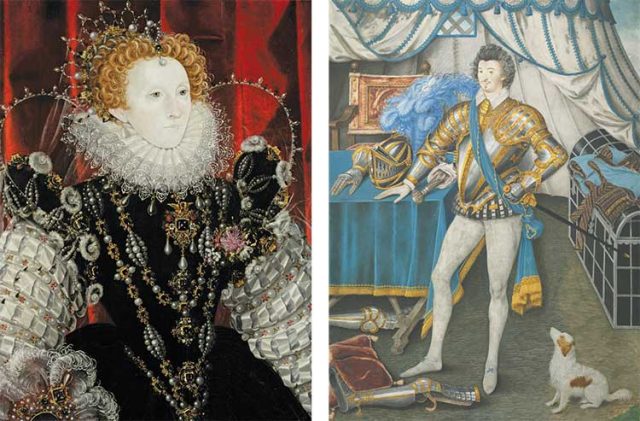The Fine Arts Museums of San Francisco will present on June 24 the first major exhibition in the United States of portraiture and decorative arts of the Tudor courts. The Tudors are arguably the most famous and notorious dynasty of England, and also some of the greatest art patrons of their time.
HISTORY REUNITED
The exhibition will be organized in a chronological visual narrative, tracing the art across the reigns of five Tudor monarchs and their individual personalities represented in layers of textiles, prints, and paintings.
“Thanks to Hollywood movies and TV dramas like The Tudors, many Americans have heard of King Henry VIII and his six wives, as well as the “Virgin Queen” Elizabeth I, but few may be aware of the distinctive art and visual propaganda that was central to the splendor and drama of the Tudor court,” said Thomas P. Campbell, director and CEO of the Fine Arts Museums of San Francisco. “The Tudors: Art and Majesty in Renaissance England” “. . . reunites scores of sumptuous paintings, precious jewels, gilded tapestries and rare artifacts from collections around the world to bring the Tudor dynasty vividly to life — from the bloody founding of the dynasty in 1485 by Henry VII on the fields of Bosworth, to the final moments of Queen Elizabeth in 1603.”
PATRONAGE AND POLITICAL STRIFE
Despite political and religious upheaval, the arts flourished under the Tudors’ patronage. Art was used as an instrument to project an image of regal splendor and authority. The 80 works on view will include portraits, as well as large- and small-scale objects ranging from tapestries to jewelry and other symbolic objects of the court.
Henry VII seized the crown, concluding the Wars of the Roses and founding the Tudor dynasty. A velvet and cloth-of-gold clerical vestment commissioned for his chapel is among the most extravagant textiles in the exhibition, which also includes tapestries commissioned by both Henry VII and Henry VIII.
Henry VIII built numerous palaces and supported many artists, most notably the German painter Hans Holbein the Younger. Holbein’s iconic oil on wood Portrait of Henry VIII (1540) and his portrait of Henry VIII’s third wife, Jane Seymour, helped to enhance his reputation as one of the most successful portraitists and designers of the 16th century.
Henry VIII famously severed ties with the Roman Catholic Church in 1534 and established the Church of England, with the king as the head of the church. The arrival of Edward VI brought radical Protestantism to England, and during the reign of Edward’s sister Mary I, England reconciled with the Roman Catholic Church and more than 280 Protestants were burned at the stake for heresy. A whimsical portrait of the boy-king in bright orange robes called Edward VI as a Child (ca. 1538) by Holbein will be on display, as will a portrait medal of Mary I in profile.
Nicholas Hilliard’s otherworldly painting, Queen Elizabeth I (1533–1603), (ca. 1576–1578) and Hardwick Portrait (ca. 1590–99) remain the most well-known images of the monarch. Her reign was remembered as a golden age, and an era of prosperity during which English forms of painting, architecture, and decorative arts flourished. The Heneage Jewelwill be on display, also by Hilliard. This gold locket pendant set with diamonds and rubies is one of the finest Elizabethan jewels from the queen’s reign and shows Elizabeth I in profile; its hinged, enameled back depicts an ark, representing the English Church, on a stormy sea.
IMAGE AND CEREMONY
Art was used to legitimize their reigns, but how did this imagery rally the people toward the royals, and in what context did the public view them? Most of the art was reserved for the royal palaces and houses, restricted to the court and inner court. During coronation ceremonies, works were wheeled out for the processions. Processional routes were typically lined with tapestries, then the regalia of the crowns and coronation ornaments. Royal visitations created another opportunity to make a grand impression when the reigning monarch went to different parts of England. During these stately visits, garments, cloths, velvets and jewels traveled in keeping with the ceremony of monarchs surveying their kingdom.
The Tudors were very significant patrons of the arts but their works were scattered to the four winds during the civil wars of the 1640s and 1650s when significant portions of the royal collections were sold. The array of paintings, tapestries, sculpture, metalworks, and manuscripts of the Tudor era represented in this exhibition have rarely been seen together and enjoyed by the general public.
“The Tudors: Art and Majesty in Renaissance England”: Tue.–Sun. 9:30 a.m.–5:15 p.m., June 24–September 24, $30, Palace of Legion of Honor, 100 34th Ave., Lincoln Park, 415-750-3600, famsf.org
Sharon Anderson is an artist and writer in Southern California. She can be reached at mindtheimage.com.




